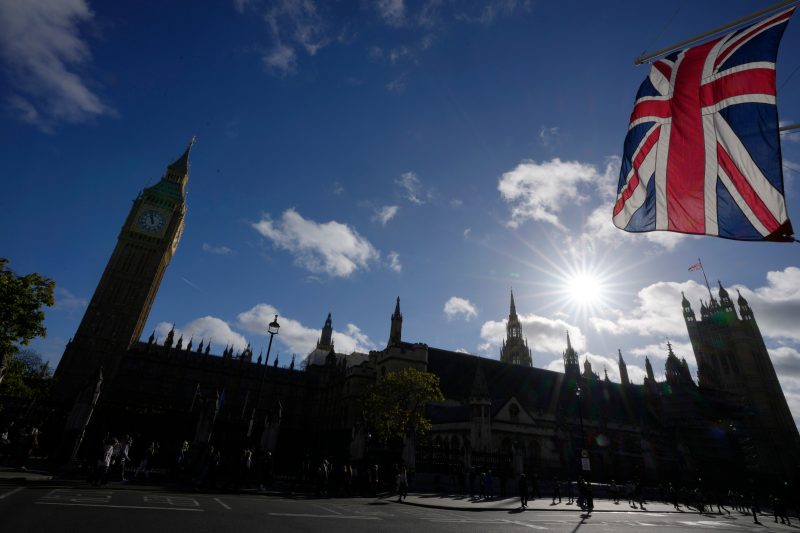7,000 killed since January in fighting in DRC, prime minister says
Britain’s Conservative Party, like the U.S. Republican Party, is in turmoil


LONDON — Five years ago, Britain’s Conservative Party scored a landslide victory in a general election that contained outlines of a realignment in that nation’s politics. Today, those same Conservatives appear headed for one of their worst defeats in a generation, an unraveling of a once-proud party that has come with astonishing swiftness.
Based on current polls, the general election that will be held in the coming months — the date has not yet been set — looks likely to restore a reinvigorated Labour Party to power after 14 years in the minority. Those same polls suggest that Labour could emerge with a majority in the House of Commons that rivals or eclipses its strength after the 1997 election that brought former prime minister Tony Blair to power.
The decline and fall of the Conservatives is the story of a political party that has become exhausted and inward-looking after more than a decade in power. Not unlike the Republican Party in the United States, it is riven by factionalism, stained by scandal and judged by many voters as incapable of dealing with the country’s problems — all amplified by a whipsawing series of leadership changes.
Since 2010, Britain has had five Conservative prime ministers, including three in 2022 alone. One of them, Liz Truss, lasted just seven weeks. That record tops by one the number of U.S. House speakers Republicans have run through in the same period.
That both the British Conservative Party and the U.S. Republican Party are experiencing division and infighting suggests some parallelism between the two parties. What they share is that both are engaged in debates about the future of conservatism. But there are limits to the similarities. Though both are in turmoil, the two parties are not exactly alike.
The Republican Party has congealed around former president Donald Trump. The Conservatives, also known as the Tories, have more or less come apart. As one former British government official put it, the Republican Party has become a Trumpian cult while the Tories still operate under more “small d” democratic principles — at least for now. That, however, does not mitigate the trouble the Tories are in.
The question that will come to the fore if the Conservatives lose as badly as some polls predict is whether they will be captured by fringe elements, who some analysts fear would make the party far more right-wing and hard-line on issues such as immigration, and ever more anti-Europe; potentially, more Trumpian.
There are almost certain to be forces of resistance to such moves, with party members and others calling for a rejection of the extremes and pushing to move the Tories back to something closer to traditional conservatism. Right now, the only consensus is that a bracing internal war for the party’s future is looming.
British politics have been through a whirlwind over the past decade: a failed referendum on independence for Scotland in 2014, a general election in 2015, the Brexit referendum in 2016 that took Britain out of the European Union, another general election in 2017, then the election in 2019, followed by two years of the pandemic and then the rapid succession of leaders in 2022.
The turmoil has left voters exhausted — sick of politics, as one strategist put it — yet another parallel to the United States. They are disillusioned with the current government and more than ready to make a change, according to strategists in both major parties.
In some ways, the Conservatives have never recovered from the Brexit vote, which was never intended to play out the way it did. The decision to leave the E.U. forced David Cameron, who had called the referendum expecting voters to say they wanted to stay in Europe, to resign as prime minister. His successor, Theresa May, struggled to implement the terms of the breakup as the leader of a badly divided party. She stepped down at a low point in the party’s fortunes in the spring of 2019.
May was succeeded in 2019 by Boris Johnson, the bluff former mayor of London, whose combination of charisma, bluster, enthusiasm and big-government conservatism worked for his party at least briefly, most notably by helping to produce a big victory months after he claimed the top post.
In that election, the Conservatives made significant inroads in areas of northern England that once had been Labour Party strongholds. The Tory victories were not unlike gains by Republicans under Trump among White working-class voters in northern industrial states. These were British districts that had seen their economies crumble, areas where the issue of immigration resonated and resentment toward elites had risen. They were districts that had supported the Brexit referendum in 2016.
Labour inadvertently contributed to the Tories’ success in 2019. The party was led by Jeremy Corbyn, a far-left politician whose history and views proved anathema to many voters, not only in those working-class areas but also among moderates in the suburban areas around the big cities. As in the United States, those suburban voters, particularly college-educated women, have been shifting allegiance. But they would not go for Corbyn’s politics.
Johnson was neither disciplined nor serious enough as prime minister to be an effective leader for the long term. He was finally brought down by the scandal that became known as “Partygate.” He and his staff were found to have partied inside No. 10 Downing Street in violation of the lockdown imposed on the British public during the pandemic. A 2023 inquiry concluded that Johnson had repeatedly misled Parliament about breaking the covid rules.
After Johnson was forced from power, the Conservatives turned to Truss, who put forth an aggressive and politically misguided economic program that called for significant tax cuts. The plan triggered a backlash in the markets and put the country’s weak economy into an even more tenuous position. Truss was out almost before she could unpack.
At that point, the Conservatives selected as prime minister Rishi Sunak, a wealthy technocratic politician who came with no public mandate, having never faced the voters in a general election. Over time, he has failed to persuade voters that he has the strength or vision to turn the country around.
The result of these years of chaos and leadership turnover is that the Tories could now suffer a double reversal from 2019: They could lose many of those newly won working-class districts while shedding suburban voters who could not stomach Corbyn but are not particularly alarmed by the Labour Party’s current leader, Keir Starmer.
Starmer has rebuilt the Labour Party, working to purge it of Corbynism and its corners of antisemitism. He has tried to put his focus on the broader electorate rather than the narrower segment of official party members. He came to politics late, after a career as a public prosecutor. His roots are humble, his politics more left-leaning than, say, Blair’s of a quarter-century ago. But in the time as leader, he has cautiously moved his party toward the center. Still, the question of how he would govern remains.
On Thursday, there will be local elections in Britain. Conservatives are expected to suffer significant losses, perhaps as many as half of the seats they hold that are up for reelection. Most closely watched, however, will be two races for mayoralties currently in Tory hands. Losses in those races will be taken as an indicator of a shellacking in the general election and time to press the panic button.
Current thinking is that Sunak will call the general election for late in the year, perhaps around the time of the election in the United States. But his team has been urged to move up that timetable to a summer election, depending on the outcome of the local elections.
The Tories have been the most durable political institution in Britain’s long history, skilled especially at winning elections. That could keep Labor strategists from becoming complacent in the face of favorable polls. It also gives Tory strategists some hope that the anticipated losses will not be on the scale that some are suggesting. But after more than a decade in power, the Tories face what could be a long period out of government — and with it an existential crisis about their future.
Across the Atlantic, Republicans will await the results of the November elections — and Trump’s fate — to know the timing and the contours of an internal battle they know is coming.











